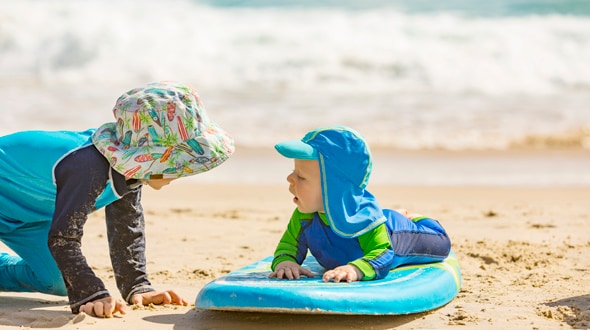Why Australians need to be sun smart
Australia has some of the highest UV radiation levels in the world, increasing our skin cancer risk.
The incidence of skin cancer in Australia is one of the highest in the world, with skin cancers accounting for 80% of all newly diagnosed cancers each year, the Cancer Council Australia warns.
There are three main forms of skin cancer:
- basal cell carcinoma
- squamous cell carcinoma
- melanoma, which is the most dangerous.

It’s not enough to slip, slop, slap
According to the Cancer Council Australia, the majority of skin cancers in Australia are caused by exposure to the sun. Melanoma, the deadliest form of skin cancer, is the third most common cancer diagnosed in Australians (with the potential exception of keratinocyte cancers, on which data isn’t routinely collected).
While most Australians are well-trained in the routine of slipping on a shirt, slopping on sunscreen and slapping on a hat, that regimen has now expanded to include seek out shade and slide on sunglasses.
UV radiation exposure that doesn’t cause sunburn can still damage your skin cells, causing wrinkling, sagging, discolouration and increasing your risk of skin cancer. This is why commercial solariums have been banned and, while fake tan is a safe alternative to the real thing, it doesn’t provide any sun protection.
The Vitamin D deficiency myth
Vitamin D, provided naturally via sunlight, is vital for muscle and bone health. In recent years, our efforts to protect ourselves from the sun’s damaging effects has led to fears of vitamin D deficiency. Cancer Council statistics, however, state that the majority of Australians can maintain adequate levels of vitamin D through regular incidental exposure to the sun.
So how do we strike a balance between sun safety and healthy vitamin D exposure? In hotter parts of Australia, people generally absorb enough vitamin D carrying out daily activities such as hanging out washing and walking to the car.
In the rest of the country, early morning and evening are likely to be the best times of day to get a little extra sun. A more accurate guideline is that if UV levels are three or higher, you need sun protection, which is where the SunSmart UV Index comes in handy.
The SunSmart UV Index
It doesn’t have to be a blistering hot day for the sun’s UV rays to cause skin damage. Even on cooler or cloudy days you still need to apply sun protection measures. Before heading out, check the Cancer Council’s SunSmart UV Index, which clearly indicates the times of the day where UV radiation levels are highest.
The Index is available via the free SunSmart app for both Apple and Android devices.
Check the UV index when you’re:
- planning outdoor events
- exercising outdoors
- watching outdoor sports such as tennis or cricket
- work outside or on water
- heading to the pool or beach
- planning to be outside with children.
Sun protection checklist
In addition to applying SPF50+ sunscreen 20 minutes before heading outdoors and every two hours after during the warmer months, wear a hat and UV-resistant sunglasses.
Check your skin regularly, looking for:
- crusty sores that don’t heal
- small red, pale or pearly coloured lumps
- new spots, freckles or moles that change shape or colour, especially if they’re dark.
See your doctor immediately if you find anything questionable. The sooner skin cancer is identified and treated, the better.
This article was originally published in Fit&Well in November 2016. Updated October 2021.
Related articles
STAYING HEALTHY ON HOLIDAYS
From food safety to travel vaccinations, here’s how to have a happy, healthy holiday.
WHY YOU SHOULD DO A SKIN CANCER CHECK TODAY
Here’s how to keep an eye on your skin and lower your risk.
5 SIMPLE WAYS TO TRY OUTDOOR FITNESS
Get busy with our five ideas for outdoor fitness activities.
POACHED PEAR AND FIG SALAD WITH CARAMELIZED WALNUTS
A modern Mediterranean salad that's rich in plant omega-3 fats.